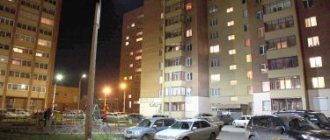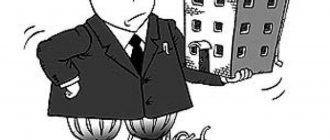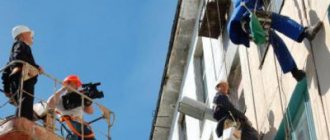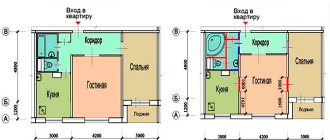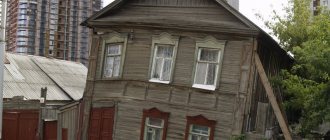Construction objects have a standard service life, established depending on the materials used to manufacture the load-bearing elements, conditions of maintenance and use.
In fact, various buildings are used for longer than the established norm with proper maintenance and major repairs. If residential, public and industrial real estate is treated negligently, premature wear and decommissioning occurs.
What is service life
The period of existence of a construction project from the moment of construction until the moment of complete wear, destruction or disassembly is called the service life.
Buildings and structures not used for their intended purpose, mothballed or abandoned, continue to wear out, counting down the time of their serviceability.
The construction material of load-bearing structures significantly affects the period of operation of the object, and the service life of a panel house is longer than the service life of a wooden house.
Standards and service life of high-rise buildings in Russia
A person rarely thinks that his home will one day be demolished. The native corner seems eternal and unshakable. But everything has its time, just like residential buildings, which sooner or later will turn into a pile of ruins. In their place, a new building will rise into which other people will move in, and a new cycle of urban life will begin.
How soon will a five-story Khrushchev building, a monumental Stalinist building or a high-rise building in a new residential complex live out its life?
Features of home operation
The issue of demolishing the old building is being considered from different angles. Standard operating periods are, rather, approximate figures that city planners can use as a guide, but do not necessarily follow.
An old five-story building, built on a good foundation and with major renovations, can stand for another half a century, while a brand new house can fall apart at the seams in a couple of years.
What people pay attention to when the question is raised about the lifespan of a house:
- Condition of housing. The most important point. Emergency buildings must be occupied as soon as possible, because this threatens human lives.
- Economic expediency.
- Appearance. In the central part of most cities there are bound to be dilapidated buildings that spoil the overall picture. Such buildings are either demolished or renovated with mandatory façade finishing.
- Cultural and historical value. It is not at all easy to demolish such a building - an order is not enough for this. If the building is really so valuable, then it can stand for centuries, but it will certainly need restoration.
Panel house.
Service life of various types of residential buildings
Each era in the history of our country brought something of its own to urban planning. The Stalin era with its Empire style gave the country beautiful and durable houses, the post-war era - a huge amount of nondescript, but affordable housing. In modern times, residential high-rise buildings made of glass and concrete are springing up everywhere, as if out of the ground.
Find out what a meeting of owners is and how to conduct it here.
All this has its own standard expiration dates.
- Stalin's buildings. Service life – 125-150 years. They were built from 1930 to 1956.
- Housing that can be called elite without hesitation. Spacious rooms, high ceilings, beautiful exterior decoration of the building - all this reflected the desire of the country's leadership to show how the young Soviet state was growing and strengthening.
- Five-story panel houses. Service life – 50 years. They were built from 1955 to 1970 (in some cities until the early 80s).
- Back in the USSR, these houses were planned as temporary. But, unfortunately, the temporary has become “permanent” and is already worth even more than it should be due to the terms. In Moscow, panel Khrushchev buildings are being rapidly disposed of, but in the provinces they still exist in huge numbers. Not long ago, it was decided to carry out a major renovation program for such houses, which includes: insulation, external and internal decoration, and reconstruction of individual parts. Everything suggests that these temporary panels will last for more than one generation: cramped apartments that do not retain heat well are cheap, and therefore there is always a demand for them.
- Brick five-story houses. Service life – up to 100 years.
- A more comfortable version of the "Khrushchev" apartments. Brick houses are warmer and have better sound insulation, and their service life is twice as long as that of panel houses.
- Panel and block houses of the Brezhnev era. Service life – up to 100 years. Built from 1965 to 1980.
- By analogy with “Khrushchev” houses, such houses are called “Brezhnevka”. The height of the houses varies from 9 to 16 floors. They have elevators and garbage chutes (the latter most often do not function today). The ceilings are higher and the kitchens are more spacious.
- Modern panel residential buildings. Service life is about 100 years. Built from the late 80s to the present day.
- Since today houses are most often built according to individual plans, the quality of such housing and its service life are very difficult to predict. It happened that within a month the happy owners of an apartment in such a house discovered cracks in the load-bearing walls.
- Modern brick, monolithic and monolithic-brick houses. Service life – 100-150 years. Built from the late 80s to the present day.
- The qualities of a well-built monolith made of concrete or brick house are excellent noise and heat insulation and resistance to environmental influences.
This video will tell you what the pros and cons of panel houses are:
Service life of buildings according to SNIP
The table shows the approximate service life of various buildings.
How to avoid paying for major repairs, read the link.
| Buildings and structures erected for temporary residence (kiosks, pavilions, cabins for builders and workers, market structures) | 10 years |
| Buildings and structures operated under aggressive environmental influences (pipelines, chemical industry tanks, storage facilities, etc.) | 25 years |
| Industrial, residential and commercial buildings of mass construction (residential buildings, industrial buildings, shops, public service buildings, etc.) | From 50 years old |
| Unique buildings, buildings of cultural value (stadiums, theaters, museums, repositories of national treasures) | From 100 years and above |
Examination of the condition of a residential building
Reasons for examination:
- Excessive wear and tear on a residential building;
- Non-compliance with required standards;
- Trial.
Find out how to determine which area is adjacent to your home by following the link.
The procedure for inspecting a building by experts looks like this:
- Visual assessment of all systems of a residential building (foundation, supporting structures, sanitary systems);
- Instrumental assessment of all systems of a residential building;
- Inspection of living conditions (quality of drinking water, sewerage, air and soil pollution).
What ODN is and how you can calculate it yourself is described in this article.
Based on the examination, a conclusion is made about the suitability of the house. If the wear is more than 70%, it will be considered emergency. A slightly lower degree of wear and tear is also a reason for either demolition of the building or major repairs.
How much do houses cost?
If the house is not recognized as unsafe, but certain aspects in the conclusion are considered to be non-compliant with the standards, the question of reconstruction and finishing of the building will be raised.
How you can manage an apartment building, read more here.
When the house reaches its last days
A decision on the unsuitability of a residential building is made by a judicial commission based on the conclusion of an expert group.
What work must be included in the landscaping of the territory, read the link.
If a decision is made, the building has two options:
- Major renovation. For it, two conditions must be met: the technical feasibility of the repair and its feasibility. Repairs can be carried out if the building has a safety margin and there are no serious risks for its occupants.
- Demolition. A building recognized as unsafe and potentially dangerous is subject to demolition.
Which house is better, watch in this video:
Our country's housing stock is gradually deteriorating. The country inherited a huge number of residential buildings from the Soviet Union, and many of them could very soon become unsafe. Resolving issues regarding the construction of new houses is one of the most important tasks facing the state.
Attention! Due to recent changes in legislation, the legal information in this article may be out of date! Our lawyer can advise you free of charge - write your question in the form below: Attention! Due to recent changes in legislation, the legal information in this article may be out of date! Our lawyer can advise you free of charge - write a question in the form below: Attention! Due to recent changes in legislation, the legal information in this article may be out of date! Our lawyer can advise you free of charge - write a question in the form below:
Source: https://ProNovostroyku.ru/yuridicheskie-voprosy/mnogokvartirny-j-dom/sroki-e-kspluatatsii-domov.html
Various periods
The time of use of a construction project is divided into periods of running-in, normal operation and intensive wear.
At the first stage, the elements of the structure are ground in, run-in, shifts appear, and shrinkage occurs. The process of loss of strength begins and the bulk of defects and violations are identified, which are eliminated or localized.
During the period of normal operation, the behavior of the elements of the structure stabilizes; the manifested deformations are associated with the conditions of use and arise unexpectedly.
As you age, there comes a period of intense wear and tear. During operation, all components of a building or structure lose their qualities, strength and stability decrease, and the characteristics and properties of materials deteriorate.
The three stages of an object’s life have normative and actual periods for each individual element and the entire complex.
Normative
The name itself suggests a connection with building codes. Russian legislation sets standards for the service life of buildings and structures of various types. During the design process, designers take these standards into account and, calculating effective functioning, offer materials that can withstand the entire designated period.
Actual
Unlike the normative one, the actual period depends on the operating conditions, the materials used, design solutions and capital of the facility as a whole.
The actual period of operation of the facility with regular and timely current and major repairs may be longer than specified by the standards. If the condition of the building is not monitored and the schedule of prevention and restoration is violated, then the object may not survive to the standard date.
Service life of a panel apartment building: according to standards in accordance with GOST
19 November 2020 5:00
Hello, friends! Probably, among the people reading this article there will be those who were lucky enough to build or buy a private house, cottage or even villa.
For some time now, people's desire to live in a house rather than an apartment has intensified.
People are returning to the villages, although not so long ago, it would seem, whole families left them, only the oldest residents were left to live in dilapidated houses.
The massive desire of residents for dachas is also understandable. People are drawn to nature, they are tired of the polluted air of cities, they want solitude and peace. But the vast majority of Russian citizens continue to live in apartment buildings. Although today not everyone manages to have their own apartment. The housing issue, which Bulgakov’s Woland so rightly said, remains relevant.
Someone has the opportunity to purchase housing in new buildings, and this is a good purchase, because modern houses are very comfortable, with a good layout, and convenient. Of course, there is no need to compare them with the five-story buildings of Khrushchev's time. Nevertheless, panel houses remain in demand on the secondary market.
What is the reason for this demand? the reason is cheapness. Let many houses have low ceilings, tiny kitchens, and a combined unit. However, often purchasing just such apartments is the only way to solve the housing problem. However, those who live or are just planning to buy housing in such a house are faced with an important question: the service life of a panel apartment building.
Homes don't last forever either
Quite often we don’t think about when the house was built, how long it was designed to last, what its design features and weak points are. It seems to us that we will always have the purchased housing. Nevertheless, the history of the demolition of five-story “Khrushchev” buildings in Moscow suggests that houses also have a lifespan. The time comes and it ends.
For any house, be it panel or brick, there are its own standards and GOSTs. They talk about the approximate service life.
Why approximate? Because a lot depends on the operating conditions, whether or not major repairs are carried out, the quality of the work performed, etc.
Sometimes a newly built house after two or three years is far from ideal condition, but a 9-story panel house is preserved very well.
Brick, panel, monolith
Still, the material from which a house is built is important. Still, a brick and a panel house are two big differences.
SNiPs contain approximate service life of buildings made of different materials. The longest service life is for permanent structures, in the construction of which stone, brick, and concrete were used.
SNiPs indicate a service life of 150 years. For example, post-war Stalinist cars will last that long.
Next are ordinary houses, which are also built using brick and concrete (120 years). The panel houses we are talking about today have big differences depending on the year of construction.
That is, the “Khrushchev-era buildings” built in the Soviet Union from 1950 to 1970, according to standards, can serve a person for no more than 50 years. In Moscow, these houses are being demolished, but a little further from it, they continue to stand.
Houses built in 1965–1975–1990 are called “Brezhnevka”. They were erected when the country was headed by Leonid Ilyich Brezhnev. These houses were produced in different series. At first they were 5-story panel buildings, but there was also a series of 5-story brick houses. One of the series was intended for small families.
“Brezhnevki” were not only 5-story, but also 9-story and higher - up to 16 floors. They were distinguished by an improved layout compared to the “Khrushchev” ones. They had an elevator and a garbage chute. However, the quality was not always the best. In 1979, a 15-story panel building of one of the series collapsed in Leningrad. After the tragedy, buildings in this series were no longer erected.
From the late 1990s to the present day, new monolithic panel houses have been built. They are built mainly according to individual projects and have a good layout. Although, in fairness, it must be said that less than half of panel houses are being built today. People strive to live in houses of a different - higher - level, so there are more monolithic, brick houses.
The legislative framework
When talking about the service life of buildings, we must first talk about the safety of their operation.
In Russia, the service life and, accordingly, the safety of buildings are regulated by various documents. This is determined by SNiPs, GOSTs, standards, list of national standards, etc.
These documents contain approximate deadlines. But, as we said, it is difficult to determine exactly how long a house will last.
Some of the panels last 50 years, some have a lifespan of 100 years, there are buildings made of panels, and their outer walls are brick. Their term is 150 years. Much depends on the series of the house. The service life of modern panel houses is 100–120 years. Also an important factor is carrying out major repairs. It is believed that it should be done after 20–25 years of operation.
How to extend the service life
Today, many regions of Russia have targeted overhaul programs. The owners provide funds for financing. Each region has a set price for the contribution for major repairs per 1 square meter. Lists of houses in need of major repairs are offered by municipalities. Among them are many panel houses, since these houses have a lot of shortcomings that reduce their service life.
Before you make a choice and decide to buy an apartment in a panel house, find out what series the house belongs to, what year it was built, and whether major renovations have been carried out on it. By the way, the latter leads to an increase in price, however, only if the repairs were carried out comprehensively. It often happens that the roof of a house is repaired, but everything else remains untouched.
We hope that the information contained in this article was useful to you. If you have any additions or disagree with something, we will be glad to hear your opinion on the site. Leave comments, we are always ready for dialogue.
Source: https://www.rline.tv/svobodnyj-korrespondent/srok-ehkspluatacii-panelnogo-mnogokvartirnogo-doma/
Regulatory documentation
The planned service life of the designed object is determined by agreement between the customer and the general designer. For this purpose, the approximate terms given in GOST R 54257-2010 “Reliability of building structures and foundations” are used.
The standard service life of buildings and structures is contained in various SNiP and construction regulations.
Standardized requirements and recommendations contain:
- SNiP 31-01-2003 “Residential multi-apartment buildings”,
- SP 54.13330.2011 “Residential multi-apartment buildings”,
- SP 118.13330.2012 “Public buildings and structures”, current edition of SNiP 31-06-2009 “Public buildings and structures”,
- SP 43.13330.2012 “Structures of industrial enterprises”,
- SP 56.13330.2011 “Industrial buildings”.
Types of residential apartment buildings
The distinctive features of the types of residential buildings are the production technology and the main material of manufacture.
Currently, there are types of apartment buildings:
- panel, made using large reinforced concrete structures, panels,
- monolithic, consisting of a solid reinforced concrete frame,
- block, built from a large number of prefabricated elements, like a constructor,
- brick, which are environmentally friendly, built from natural material,
- wooden, built from round environmentally friendly wood or timber.
Types of panel houses
The beginning of mass panel construction was the construction of the so-called “Khrushchev” buildings in the late 50s of the last century. They were built from lightweight thin-walled panels, thanks to which material costs were significantly reduced. Such buildings were designed for approximately 40-50 years of operation. However, according to preliminary estimates, the lifespan of panel houses of this type will be 10-15 years longer than expected. For similar buildings built somewhat later, the service life will last approximately 100-120 years.
Lifetime
A structure built in accordance with SNiP and according to the design must last the entire period specified in the design specifications. At the calculation stage, load-bearing structures (foundation, walls, ceilings) are calculated based on the service life of the entire object.
To facilitate planning of current and major repairs, setting depreciation periods, building codes and regulations provide for:
- six groups of housing capital,
- nine groups of public buildings,
- four groups of industrial buildings.
Proper operating conditions and timely repairs can increase the actual durability of buildings. Not so with the standard deadline. Despite the fact that new materials and technologies are appearing, modern buildings are planned for a shorter period of operation.
Standards
The estimated service life of construction projects depends on the material of the structures and many factors associated with wear. Taking into account the main characteristics of materials and influencing factors, standard service life has been developed.
| Group | Building characteristics | Service life, years |
| I | Capital stone. | 150 |
| II | Ordinary stone ones. | 125 |
| III | Lightweight stone. | 100 |
| V | Panel, frame, adobe, adobe, half-timbered. | 30 |
| VI | Frame-reed, from boards and lightweight others. | 15 |
For public facilities, a broader breakdown into groups is provided.
| Group | Type of buildings | Service life, years |
| I | Frame, with a reinforced concrete or metal frame filled with stone materials. | 175 |
| II | Particularly capital ones, with walls made of piece stones and large blocks. | 150 |
| III | With stone walls made of piece stones or large blocks. | 125 |
| IV | With lightweight stone walls. | 100 |
| V | With lightweight masonry walls. | 80 |
| VI | Wooden. | 50 |
| VII | Wooden panel or frame. | 25 |
| VIII | Lightweight. | 15 |
| IX | Tents, pavilions, stalls and other light trade buildings | 10 |
Shelf life
Currently, there are buildings of different years of construction. They were built using outdated technologies and materials that are not used today. To streamline the structures, they divided them into types and established average shelf life.
| Years of construction | Duration of operation | Scheduled reconstruction time | Estimated demolition period after expiration of the regulatory period |
| 1930-1940 | 125 | 1990-2005 | 2050-2070 |
| 1945-1955 | 150 | 2020-2030 | 2095-2105 |
| 1955-1970 | 50 | Program in development | 2005-2020 |
| 1955-1970 | 100 | 2015-2030 | 2055-2070 |
| 1965-1980 | 100 | Reconstruction is not planned | 2055-2080 |
| 1980-1998 | 125-150 | 2050-2070 | 2105-2150 |
| 1980-1998 | 100-120 | Reconstruction is not planned | 2070-2105 |
Service life of a 9-story panel house
Have questions? Consult a lawyer (free of charge, 24 hours a day, seven days a week):
8 – Federal number
8 – Moscow and Moscow region.
8 – St. Petersburg and Len. region
When purchasing an apartment in a new building or on the secondary market, one must also take into account such a factor as the lifespan of the building. It affects both taking into account the needs for major repairs and understanding whether it will be necessary to purchase new living space for children in the future.
Also, knowledge of this parameter will make it possible to calculate the prospects for resettlement; in Moscow alone, about 45% of the residential background is made up of panel buildings and there is already talk about the demolition of the oldest residential areas, despite the fact that SNiPs still allow their operation.
The service life of a 9-story panel house depends on several significant parameters - climate, construction requirements, and the professionalism of the developer.
Climate influence
The climatic factor will be significant when comparing the service life of buildings built in a temperate climate, in permafrost zones or in an earthquake zone. Each of these types of regions is capable of reducing the standard life span of a nine-story building or the communications connected to it.
If we consider the situation by region, the following will happen:
- in the North and similar territories, pipelines and other communications will fail faster. Buildings require increased thermal insulation; its failure determines the need for repairs. If in Chita only a few panels suddenly failed, then in Canada residents had to leave two cities that were razed to the ground by permafrost;
- in areas prone to flooding and earthquakes, a house may be destroyed significantly earlier than regulatory expectations.
Important: When studying the location of a building, it is necessary to take into account not only the climate, but also the features of the General Plan and zoning of the territory. The building may be demolished if the authorities have other plans for the use of the land.
Construction period
The architectural solution affects the duration of use of a high-rise building. When choosing an object to purchase, you must proceed from the following gradation:
- panel houses of the Brezhnev period (1965-1980). Pleasant apartments with high ceilings and a garbage disposal on the stairs attract many buyers. The standard service life of a building is 100 years from the date of construction;
- houses of modern construction. They were also planned for 100 years, but it is difficult to predict whether they will be able to function throughout this time. It all depends on the quality of construction and concrete work. Cracks in load-bearing walls are no longer uncommon; many buyers have encountered them.
So far, there have been no situations with the demolition of 9-story panel buildings due to the expiration of the possibility of their operation in Russia. If housing suitability standards do not change, the first such cases will begin to arise in the 50s of the 21st century. It should be taken into account that the construction technology does not provide for the possibility of reconstruction, so from 2055 they will gradually be demolished.
Construction quality
The service life of a panel house is often shortened due to poor quality construction. Monitoring compliance with SNiP requirements is currently not carried out at the highest level. It is even more difficult to control the process of major repairs; this task falls entirely on the shoulders of the owners.
An unsuccessful reconstruction can significantly shorten the life of a nine-story building. It should be taken into account that the calculation period for the use of this category of buildings was established in the 1965-70s.
Since then, the characteristics of the environment have changed, in many cities it has become more aggressive, and the quality of materials used in repairs has also changed. It is impossible to say unequivocally that the building will last the allotted 100 years. In many buildings built in the 2000s, there is a problem with insulation.
The interpanel seams are leaking and blown out, and the tiles are crumbling. In areas with soft soil and situations with poor-quality piles and foundations, there is a problem of uneven settlement.
Interesting: In Germany, panel houses built during the Soviet period were completely renovated as part of the federal program “Urban Reconstruction - East”. This did not change the date of their final demolition, but improved the quality of life of citizens and the appearance of the objects.
What can affect the wear and tear of a building?
The standard service life is not the only factor that influences the decision on the suitability of a building. It is extremely important to pay attention to its operating mode. The period of life established by documents will always differ from the actual one. Factors that will affect the rate of deterioration of housing will be:
- the quality of the building materials used, their compliance with SNIPs;
- compliance with technological processes during construction, temperature conditions, technology for preparing and performing individual stages of construction;
- compliance with operating conditions, quality of work of management companies, their experience in repairs;
- the quality of materials and technologies used in the overhaul process;
- the duration of periods during which high-rise buildings were unoccupied;
- the total number of residents and their relationship to the property.
Source: https://InfoNovostroyki.ru/instrukcii-i-sovety/srok-sluzby-9-etaznogo-panelnogo-doma.html
Wear
Gradually, the deterioration of structures in the aggregate exceeds the permissible limits for safe operation. When wear exceeds 75-80%, the condition of the objects is considered unsuitable for use.
In addition to the physical irreversible processes of destruction of structural strength, there is moral obsolescence, which occurs when objects lose their functional purpose, and the inconsistency of architectural and planning solutions in relation to modern requirements and demands.
Physical
Material or technical wear and tear is called physical. It implies the loss of properties of materials under the influence of external and internal factors.
The relationship between the degree of physical wear and tear and the condition of structures or the entire object:
| Physical deterioration, % | State |
| To 10 | good |
| 11-20 | Quite satisfactory |
| 21-30 | Satisfactory |
| 31-40 | Not quite satisfactory |
| 41-60 | Unsatisfactory |
| 61-75 | Dilapidated |
| More than 75 | Unusable, emergency |
The accuracy of wear determination varies in the range from 1 to 5 percent, depending on the approach and instruments used.
A common method is to determine the amount of wear and tear as the arithmetic average for each component, weighted by its share in the total replacement cost of the object. The wear of individual parts of the entire structure is determined using special tables.
Moral
The most common example of obsolescence is when a building no longer meets the parameters and requirements of modern society, its functional purpose, and architectural and planning solutions no longer meet new social demands.
Indicators of obsolescence include:
- planning flaws,
- strength, heat-insulating, sound-absorbing and hydrophobic properties of the materials used, which are far behind modern ones,
- engineering equipment is missing or of unsatisfactory quality.
Obsolescence is measured using technical, economic and sociological methods. The first develops a system of indicators based on a generalization of the unit cost of structural elements and equipment as a percentage of the replacement cost. The obtained values must be constantly adjusted.
Sociological assessment is based on analysis of the real estate market and is widely used in real estate activities.
An example of a worn-out residential building is panel buildings, called Khrushchev buildings, with tiny kitchens, low ceilings, and combined bathrooms. The relatively short service life of a panel house is also a kind of obsolescence factor.
Residual wear coefficient
Housing stock with wear and tear of 70 to 75% is considered completely worn out and unsuitable for further use. For transitions between different categories of indicators, a residual wear coefficient of 1.4 is used, calculated by the formula:
100 / 72.5 (average value from 70-75) = 1.4
Depreciation (economic indicators of wear and tear) is determined by multiplying the coefficient of residual wear and tear by physical wear and tear according to inventory data. The remaining service life of the housing stock is calculated as the difference between 100% and the residual depreciation coefficient multiplied by the actual depreciation rate divided by the annual depreciation rate.
Standard service life of panel houses
The construction of five-story panel buildings in our country began around the middle of the last century. The first such house on the territory of the Soviet Union was erected in 1948 on 5th Sokolinaya Gora Street in Moscow. It was a frame-panel structure four floors high.
The main task of that time, which the country's leadership was obliged to solve, was the creation of the cheapest development project. There was a need for residential buildings in which people could live as families, as opposed to communal settlements.
“Khrushchevka” today
Many decades later, we still associate apartments in panel buildings with cheapness and accessibility. This is real people's housing. Real estate market analysts cite the main reasons that such apartments continue to be sold: fast pace of construction, low price and slightly better quality of the latest generation of panels compared to those produced previously.
Nevertheless, nowadays panel houses occupy no more than 5% of the new building market. The fact is that for the most part, modern options sold on the market and those that are just being planned exist in monolithic technology. Quite large economy-class projects have already been developed, representing entire residential complexes.
If we consider only the secondary market, then, for example, in Moscow about 45% of it is represented by “sockets” built in different years. The oldest panel houses account for only a few percent of the total supply. And the demand for them is also low. Buying such housing is mainly the lot of those who do not have the funds to purchase something of better quality.
Why are they cheaper?
What explains the economic affordability of buildings made from prefabricated panels? The thing is that the main production load during construction is transferred from the construction site to the workshops of the reinforced concrete plant, which immediately reduces costs.
In addition to the economic factor, there is a climatic factor, because it is much easier to produce reinforced concrete elements in workshops without regard to weather conditions, and quality control is carried out in factory conditions much easier.
We all love to save, but we should not forget that the stingy pays twice. This rule also applies to panel housing construction. There are many cases when, after moving into a new standard house, problems begin just a couple of years later.
Defects can range from minor to quite serious. In some apartments, facing tiles are crumbling, in others, interpanel seams are showing through. What is the reason for this apparently premature aging? After all, a building, by definition, must be designed for a much longer service life.
The fact is that there is a concept of shrinkage, and in panel houses this process, unfortunately, occurs rather unevenly. Another pain point of such a house is its seams.
According to European construction standards, embedded seam elements are made of stainless steel, as they are recognized as one of the most important elements in ensuring the strength and reliability of structures.
But this solution is too expensive for the developer, and panel houses are deprived of their main trump card - low cost.
It is for this reason that this technology has not found its application in our country. In Russia, the joints are covered with anti-corrosion paint, which, of course, does not provide any guarantees regarding reliability.
Other disadvantages
In addition, everyone knows that the thermal characteristics of panel houses leave much to be desired. This is especially visible in comparison with monolithic and brick buildings. The heat simply disappears from the panels. In the conditions of severe Russian winters, heating an apartment in such a house becomes a serious problem.
Another classic problem with every such building is its roof. There are usually no attics in five-story panel buildings, and the roofs are very often prone to leaks.
Even if you make them gable, this will not solve the problem, since the interpanel seams quickly lose their tightness.
Some developers resort to modern sealants, but the share of such protection is too low, and this is again associated with additional costs.
About obsolescence
The fact that the service life of panel houses of the early period (popularly referred to as “Khrushchev buildings”) has actually passed, and they have become morally obsolete a long time ago is no secret to anyone.
With their tiny kitchens, combined bathrooms, low ceilings and missing garbage chute, they have long set people on edge.
Modern buyers who have more or less a decent amount of money would prefer to pay a little more than to purchase such low-quality housing at the cost of saving.
It has long been officially recognized that urban areas built up by “Khrushchev” buildings are used extremely inefficiently. These buildings do not decorate urban landscapes and cause high heat loss figures for public utilities. For a long time no one has doubted the advisability of their demolition and the construction of new modern buildings in the vacant place.
What is the service life of panel houses from the 1980s?
Service life is the criterion that allows you to assess the liquidity of a house with maximum objectivity. Let's try to evaluate our “sockets” from this point of view. If we consider the first thin-walled “Khrushchev” buildings, then the service life of panel houses from the 1980s is about 50 years. It is clear that, physically and morally, such housing has long since exhausted itself.
Another category of houses is panel and block high-rise buildings. This is a slightly more “advanced” option. Each such house has 9-16 floors. Their construction began between 1965 and 1980. The service life of the 9-story panel house is designed for 100 years.
What else could he be?
Experts say that the service life of modern panel houses of different series is approximately the same. This is due to the fact that during their construction the same standards and building rules are used.
Relatively new panel houses have a slightly longer stated service life. The service life of a panel apartment building is generally designed for a period of 50 to 70 years. For individual series (for example, P 44), this period is assigned up to one hundred years.
There is a series C 220, the structures of houses of which are assembled from panels, but the material of their external walls is brickwork. The appearance of such buildings is similar to monolithic brick ones. The standard service life of panel houses of this series is indicated within 150 years.
It should be noted that this option is not very common in the housing market.
How can I extend it?
According to the project, when operating newly constructed panel houses, a planned period between mandatory overhauls is provided, and it ranges from 20 to 25 years. In reality, real buildings last 10-15 years longer than planned without major repairs.
How much can the service life of a panel house be increased? The unspoken opinion of most experts is that the concept of normality here is very conditional, and repairs and careful treatment can prolong it. Of course, we are talking about the renovation of the entire building, and not a single apartment.
In the latter case, such an event will not have any serious impact on the general condition of the house.
Thus, according to experts, when operating panel houses, the main thing is to carry out major repairs on time and carefully monitor the maintenance of all communications in good condition.
There are standards for the number of people allowed to live in a specific area.
In the conditions of Russian reality, these standards have been violated for decades; this, accordingly, has accelerated the deterioration of most buildings.
Even the appearance of a panel house may indicate the need for repairs. Numerous cracks and more than once patched seams between the panels will tell you this. If you go inside the house, damp walls with mold and an unpleasant odor, as well as dilapidated communications, eloquently complete the picture.
An additional difficulty for repairmen is that, according to the design features, such repairs are not always possible. For example, some projects involve installing batteries and pipes directly inside the walls. These communications wear out faster than the service life of panel houses ends.
The cost of apartments after major renovations on the real estate market can be increased by approximately 15%, but this applies mainly to those buildings that have undergone comprehensive renovations.
This concept implies measures to insulate the facade with a plinth, roof, repair of staircases and attic (if any), glazing of all balconies, replacement of pipes and equipment for elevators and gas facilities, as well as major cleaning of ventilation ducts.
Maximum numbers
Such a complete renovation can significantly improve the quality of the house and significantly extend its service life. In addition, as a result of transformations, the appearance of the building can be significantly improved, which immediately increases its value on the secondary real estate market.
What is the maximum service life of panel houses? According to the standards, reinforced concrete structures are allowed to operate for up to 125 years, but subject to strict adherence to certain conditions, namely: major repairs must be carried out at least once every 25 years, and routine repairs must be carried out every seven years. In practice, getting the authorities to carry out these activities is an almost impossible task. No one is involved in the prevention and determination of the technical condition of each building. Repairs can only be achieved after numerous complaints on serious grounds.
About the reconstruction of old houses
The capital has long developed a program for relocating residents from dilapidated and five-story buildings. First of all, it is planned to resettle the oldest five-story panel buildings, the service life of which has long expired. Both in Moscow and in the regions, from time to time there were attempts to reconstruct individual Khrushchev buildings. Unfortunately, this practice can be said to have failed.
The attempts consisted in the fact that houses of a certain series were subjected to superstructure and the construction of additional sections. As a result, it was concluded that this project was not economically feasible. After all, the maximum number of built-on floors is one or two, no more.
The process of constructing additional areas on the roof caused active protests from residents. Such apartments were also not in demand among buyers. As a result, it was decided that it would be much more profitable to demolish the old housing and then build a new one on this site.
Neither the installation of elevators, nor the complete replacement of communications, nor the renovation of the entire building will extend the service life of the panel houses of the 70s and will not increase the demand in the housing market for Khrushchev-era buildings. After all, the quality of the panels, as well as the original layout of the apartments, cannot be changed. Conclusion - “Khrushchev” buildings will never become comfortable housing.
By type of structure
To satisfy their material and cultural needs, people build a variety of structures, divided according to a number of distinctive features.
According to the geometric parameters of construction projects, they are distinguished:
- volumetric,
- playgrounds (sports grounds),
- linear (roads, pipelines, power lines).
Structures located above or below the surface of the earth are called above-ground or underground, respectively.
Buildings are classified according to the number of floors:
- one-story,
- low-rise (up to 3 inclusive),
- multi-storey (from 4 to 9),
- high number of storeys (from 10 to 20),
- high-rise (more than 20 floors),
- mixed number of storeys.
According to the purpose of the building - residential, public and industrial.
Public
Capital objects intended to meet the socio-cultural needs of a person or to perform administrative functions are called public.
The following objects are considered public:
- educational institutions,
- kindergartens,
- trade and catering,
- healthcare,
- recreation for children and adults,
- sports,
- culture,
- administrative.
Industrial
Industrial buildings are widely classified according to their purpose.
Industrial facilities include:
- production,
- auxiliary production,
- energy,
- transport,
- warehouse,
- sanitary,
- auxiliary and general production.
Condition assessment
A technical condition inspection is carried out to assess the quality and reliability of the object as a whole, its elements and components. As a result, indicators are determined that take into account changes during operation, on the basis of which calculations for repairs are made.
When conducting an assessment according to technical safety regulations, sufficient and reliable information about full or limited performance can be obtained. Based on the data, the next major overhaul is predicted or planned.
Procedure
Work to inspect the condition of construction projects is a complex multi-level study.
The procedure is performed in stages:
- Familiarization with the object and drawing up a work plan.
- Preliminary inspection of building elements.
- A thorough technical study establishing the physical and technical characteristics of the structure.
- Determination of parameters of strength, stiffness and cracking resistance.
- Assessment of the technical condition and operating conditions of the facility based on the results obtained.
- Initial identification of dangerous defects, damage and deformation of elements that are in emergency condition, and development of localizing measures.
- Determining a safe method of access to the object being repaired.
- Development of measures to ensure operational requirements for the building.
The scope of survey work is determined in the customer’s technical specifications.
In accordance with the terms of reference for the study, various methods are used:
- acoustic,
- radiometric,
- magnetometric,
- vibrating.

